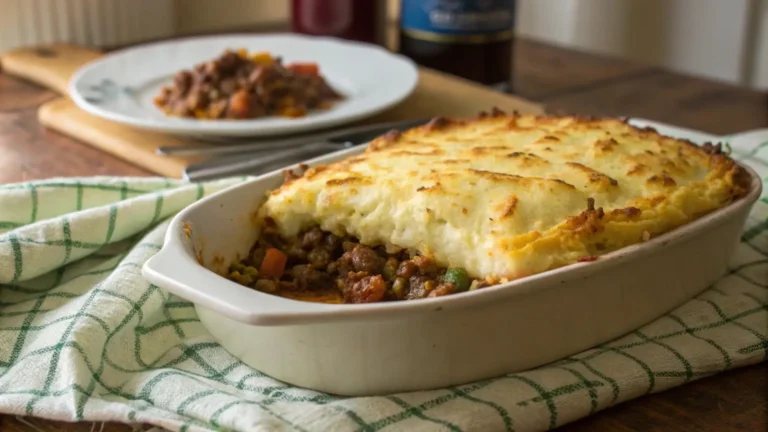Does Cream Cheese Thicken Potato Soup? How to Use It Right
Potato soup is a universally loved dish, cherished for its comforting warmth and versatility. Whether enjoyed on a cold evening or as a hearty lunch, potato soup can be easily customized to suit personal tastes. However, achieving the perfect consistency often raises questions. For instance, does cream cheese thicken up potato soup? And if so, how can you use it properly to avoid common issues, such as clumps or overpowering tanginess?

This guide provides a detailed exploration of cream cheese as a thickening agent, its benefits, how to use it effectively, and how it compares to other methods. Ultimately, by the end, you’ll be equipped to make a rich, velvety potato soup that satisfies every time.
How Cream Cheese Works as a Thickener
Cream cheese is a surprising yet effective thickening agent for potato soup. Its unique properties make it a versatile ingredient; however, understanding why and how it works is essential for achieving the best results.
Rich in Fats and Proteins
- Fats for Thickness: Cream cheese has a high-fat content that gives body and richness to the soup. Fats create a smooth, creamy texture when combined with liquid.
- Proteins for Emulsification: Proteins in cream cheese help it bond with the soup’s liquid components, forming a cohesive mixture.
Related Tip: Using Other Ingredients for Thickness
If you’re curious about how other ingredients compare, check out this article on thickening agent cream of potato soup. It explores alternative methods for creating a hearty, creamy soup.
Potato Starch: A Natural Helper
Potatoes naturally release starch during cooking, which acts as an emulsifier. As a result, when combined with cream cheese, the starch and fats work together to create a thick, luscious consistency.
The Role of Blending
To fully unlock cream cheese’s thickening potential, blending is essential:
- Immersion Blenders: These are convenient for creating a smooth texture directly in the pot.
- Countertop Blenders: These are useful for large batches; however, transferring hot soup requires caution.
- Why It Matters: Proper blending ensures the cream cheese emulsifies completely, avoiding clumps.
Step-by-Step: How to Add Cream Cheese to Potato Soup Without Clumping
Using cream cheese to thicken potato soup isn’t complicated; however, following the correct process is essential for ensuring success. Here’s a step-by-step guide:
1. Soften the Cream Cheese
- Remove cream cheese from the fridge and let it soften at room temperature for 30–60 minutes.
- Softened cream cheese blends more easily, reducing the risk of clumping.
2. Heat the Soup to the Right Temperature
- Avoid Boiling: High heat can cause cream cheese to separate, leading to a grainy texture. Aim for a temperature around 150°F (65°C).
- Keep the soup warm enough to melt the cream cheese; however, it should not be so hot that it destabilizes the proteins.
3. Add Cream Cheese Gradually
- Cut softened cream cheese into small cubes or pieces.
- Add it to the soup a little at a time, stirring constantly to incorporate each addition fully.
4. Blend for a Velvety Texture
- Use an immersion blender directly in the pot for convenience.
- Alternatively, transfer the soup to a countertop blender in small batches. Blend until smooth and creamy.
5. Adjust Consistency and Flavor
- If the soup is too thick, thin it with a splash of milk, broth, or water.
- Taste and adjust seasonings as needed. Cream cheese adds tanginess, so balance with salt or spices.
Benefits of Adding Cream Cheese to Your Potato Soup Recipe
Cream cheese isn’t just about thickening; in fact, it brings multiple advantages that enhance the overall experience of potato soup.
1. Superior Texture
- Cream cheese creates a rich, creamy mouthfeel that’s hard to replicate with other thickeners.
- The result is a soup with a velvety, luxurious texture that feels indulgent.
2. Enhanced Flavor
- Its tanginess adds depth, balancing the starchiness of potatoes and the richness of broth or cream.
- A subtle salty-sweetness elevates the soup, making it more complex and satisfying.
3. Nutritional Value
- While cream cheese is calorie-dense, it provides fats essential for energy and satiety.
- When used in moderation, it can make a balanced meal more filling and enjoyable.
Common Mistakes When Using Cream Cheese in Potato Soup—and How to Avoid Them Effectively
Using cream cheese as a thickener can sometimes lead to challenges. Here’s how to troubleshoot and avoid common problems:
1. Clumping
- Why It Happens: Cold cream cheese or insufficient blending can result in lumps.
- Solution: Always soften cream cheese and blend thoroughly to ensure a smooth consistency.
2. Overheating
- Why It Happens: High temperatures break down the proteins and fats, causing separation.
- Solution: Maintain moderate heat and avoid boiling after adding cream cheese.
3. Overpowering Flavor
- Why It Happens: Adding too much cream cheese can make the soup overly tangy or rich.
- Solution: Start with a small amount (e.g., 4 ounces per quart of soup) and adjust to taste.
FAQs: Using Cream Cheese as a Thickener in Potato Soup Recipes
Here are some frequently asked questions, along with expert tips, to help clarify any doubts:
1. Can I use cream cheese in all types of potato soup?
Yes! Cream cheese works best in creamy-style potato soups. For broth-based soups, consider adding it sparingly to maintain a lighter texture.
2. What are alternatives if I don’t have cream cheese?
- Sour cream or yogurt for tanginess.
- Heavy cream for richness.
- Vegan cream cheese for plant-based diets.
3. Does cream cheese affect the soup’s shelf life?
Yes, dairy-based soups should be stored in the refrigerator and consumed within 3–4 days to prevent spoilage.
4. Can I use flavored or low-fat cream cheese?
Yes, but note that flavored cream cheese can alter the taste; on the other hand, low-fat options may result in a less creamy texture.
5. What is the best ratio of cream cheese to soup?
A good starting point is 4 ounces of cream cheese per quart of soup. Adjust based on desired thickness and flavor.
Creative Variations for Cream Cheese Potato Soup Recipes
Looking to add a twist to your potato soup? Here are some ideas:
Flavor Enhancements
- Toppings: Sprinkle crispy bacon bits, shredded cheddar, or chopped chives for extra flavor.
- Herbs and Spices: Add thyme, rosemary, paprika, or cayenne for depth and warmth.
Vegetarian and Vegan Options
- Substitute regular cream cheese with vegan cream cheese made from cashews or coconut milk.
- Add sautéed mushrooms or roasted vegetables for added flavor.
Regional Twists
- Add jalapeños and cilantro for a Tex-Mex flair.
- Incorporate smoked paprika and sausage for a Spanish-inspired version.
Comparing Cream Cheese to Other Potato Soup Thickeners
How does cream cheese stack up against other thickening agents commonly used in soups?
1. Heavy Cream
- Pros: Easy to use, mild flavor.
- Cons: Lacks the tanginess and thickness of cream cheese.
2. Flour or Cornstarch
- Pros: Effective for achieving a smooth texture.
- Cons: Can result in a starchy taste; lacks the richness of cream cheese.
3. Yogurt or Sour Cream
- Pros: Adds tanginess similar to cream cheese.
- Cons: Less effective as a thickener, may curdle if overheated.
Regional and Cultural Variations of Potato Soup with Cream Cheese
Potato soup has diverse variations across cultures. Here’s how cream cheese fits into the mix:
- American: Often enriched with cheddar, bacon, and cream cheese for a rich, hearty dish.
- European: Recipes may use sour cream traditionally but increasingly incorporate cream cheese for its tanginess.
- Vegan Adaptations: In modern cuisine, vegan cream cheese is used to replicate the creamy texture.
Final Tips for the Best Cream Cheese Potato Soup Recipe
Here are some extra tips for success:
- Choose the Right Potatoes: Russets are ideal for their high starch content, which complements cream cheese.
- Add in Layers: Incorporate cream cheese gradually to avoid overwhelming the flavor.
- Experiment with Liquids: Use chicken broth, vegetable stock, or even a splash of white wine for added depth.
Conclusion
So, does cream cheese thicken up potato soup? Absolutely! With its unique combination of fats, proteins, and tanginess, cream cheese is undeniably a powerful tool for creating rich, velvety soups. By following the proper techniques and avoiding common pitfalls, you can, in turn, transform a simple potato soup into a luxurious dish that’s perfect for any occasion.
Whether you’re sticking to the classic recipe or experimenting with variations, cream cheese is, without a doubt, your secret weapon for thick, creamy, and flavorful potato soup.






